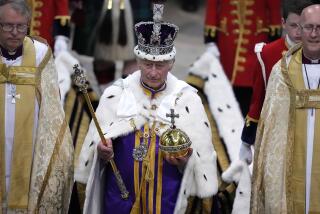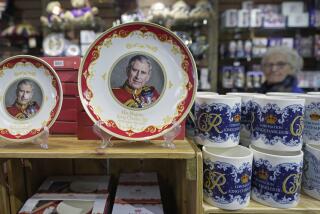Akihito Enthroned in Japan : Asia: Cheers of ‘banzai’ congratulate the emperor. About 500 dignitaries from around the world attend. Leftists are blamed for 21 ‘terrorist’ acts.
TOKYO — Against a backdrop of violent protest by clandestine radicals opposing Japan’s imperial system, Emperor Akihito declared to the world today his accession to the ancient Chrysanthemum Throne.
Royalty, heads of state and special envoys from 158 nations assembled under strict rules of protocol at the Imperial Palace in central Tokyo to attend the stiff, 30-minute enthronement rite--the first such ceremony in 62 years.
Akihito, dressed in brownish-gold imperial robes, mounted his canopied, 31-foot-tall throne called the Takamikura and vowed to uphold Japan’s modern constitution. Prime Minister Toshiki Kaifu then congratulated the emperor and led the nation in three cheers of “Banzai!”
A Self-Defense Forces artillery unit in a nearby park punctuated the nationally televised rite by firing a 21-gun salute to the new emperor.
But these were not the only fireworks marking the occasion. The quasi-government Japan Broadcasting Corp. (NHK) reported a total of 21 incidents of “terrorism” aimed at disrupting the ceremonies, although none resulted in injuries.
Leftist extremists fired homemade rockets at five military bases, including a U.S. naval base, police said. A series of arson attacks at Tokyo area train stations and half a dozen Shinto shrines were blamed on the radical groups.
Sunday evening, two small bombs exploded harmlessly outside the residence of U.S. Consul General Gregory Johnson in Nishinomiya, near Kobe in western Japan. But it was not immediately clear whether the bombing at Johnson’s home was directly related to protests against enthronement ceremonies in Tokyo. Police said they found what appeared to be an explosive device at a nearby Shinto shrine.
Authorities have put in place stringent security measures--involving the deployment of an unprecedented special force of 37,000 police officers nationwide--to guard against terrorism. Concern was heightened by a Nov. 1 bomb blast at a police dormitory in Tokyo that killed one police officer and injured six others.
About 500 foreign dignitaries, including Vice President Dan Quayle and Britain’s Prince Charles and Princess Diana, watched Akihito, 56, go through the state-sponsored Sokui-no-rei, the first of two major enthronement ceremonies. The second, more controversial and religious in nature--the Daijo-sai--will take place Nov. 22-23 without foreign guests.
Akihito technically became emperor when his father, Hirohito, who is known posthumously as Emperor Showa, died at the age of 87 on Jan. 7, 1989. But centuries-old tradition dictates that an official year of mourning must pass, followed by a full season to plant and harvest a crop of sacred rice, before the new emperor can be formally enthroned.
Today’s enthronement rite was a secularized event that, until the end of the last century, had been conducted in the style of a Chinese court ritual. Akihito, perched atop his black-lacquered, guilded and phoenix-topped throne, uttered a solemn oath to uphold his role as Japan’s symbolic constitutional monarch.
“I pledge anew that I shall observe the constitution of Japan and discharge my duties as symbol of the state and of the unity of the people, always wishing for the well-being of the people,” Akihito said.
His wife, the Empress Michiko--the first commoner to marry into the imperial line--sat next to him on a smaller throne, looking like an elaborate doll in flowing white and red traditional court dress.
Akihito said he would carry on “in the same spirit as my father, Emperor Showa, who during his reign spanning more than 60 years shared joys and sorrows with the people at all times.”
The emperor said he would “ardently hope that our country, through the wisdom and unceasing effort of the people, will achieve further development and contribute to friendship and peace in the international community and the well-being and prosperity of mankind.”
The courtyard before the emperor and empress was busy with colored banners--sanitized by officials of any religious symbols--and rows of functionaries in traditional garb bearing swords and bows. Crown Prince Naruhito and other members of the imperial family took positions near the thrones, wearing colorful costumes of the ancient court.
As many as 2,500 guests were arrayed in nearby halls and on verandas around the courtyard, straining for a glimpse inside the Seiden, as the throne room is called.
When Hirohito was enthroned as emperor in 1928--the last time such a ceremony was held--the Japanese premier addressed him from a lowly position in the courtyard. But this time, reflecting Akihito’s postwar status as a mere “symbol” of authority, Kaifu offered his congratulatory remarks from the floor of the Seiden.
“We, the people of Japan, revere Your Majesty as symbol of the state and of the unity of the people, and pledge with new resolve to devote our utmost efforts to building a Japan open to the world, vigorous and culturally rich, and to promoting world peace and the well-being of mankind,” Kaifu said. “I pray for peace and stability in this era of Heisei and for prosperity for our majesty.”
Heisei, the name given to Akihito’s reign, means “attaining peace.”
Foreign guests were not expected to join in as Kaifu led those present in cheers of “banzai,” which literally means “may you live 10,000 years” but is still widely associated overseas with maniacal devotion to Emperor Hirohito during World War II.
Today’s Sokui-no-rei ceremony marked the beginning of a $94-million, 10-day period of ceremonies and court banquets celebrating the accession, culminating in the mysterious Daijo-sai--an all-night ritual of communion with the Sun Goddess. The latter rite is interpreted by many critics and imperial loyalists alike as symbolizing the deification of the emperor as the tribal patriarch of the Japanese people.
Critics have complained that the enthronement ceremonies violate the postwar constitution, which strictly separates state and religious affairs. The emperor was worshiped as a living god under the system of state Shinto that prevailed through the end of World War II.
Akihito was to change into a tail coat before an imperial motorcade takes him in an open limousine through central Tokyo this afternoon en route to the Akasaka Palace, where he resides. The emperor and empress will host seven court banquets for 3,500 guests through Thursday.
An imperial amnesty for 2.5 million lawbreakers--mostly traffic offenders and election law violators--will coincide with the enthronement. Today is a national holiday, and many Tokyo residents are taking advantage of the three-day weekend to travel outside the city.
Kaifu, meanwhile, is enjoying a diplomatic windfall, conducting a series of bilateral meetings with visiting heads of state, with many of the meetings centering on requests for Japanese economic assistance.
Before he leaves Japan on Thursday, Vice President Quayle will meet with Kaifu to discuss the Persian Gulf crisis and regional security, a Quayle spokesman told reporters in Washington.
More to Read
Sign up for Essential California
The most important California stories and recommendations in your inbox every morning.
You may occasionally receive promotional content from the Los Angeles Times.










